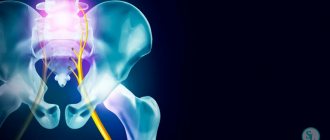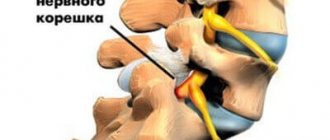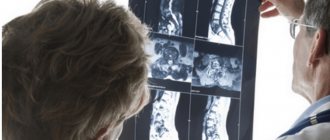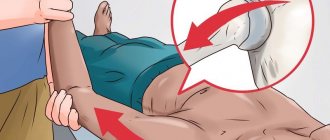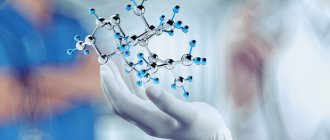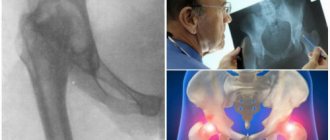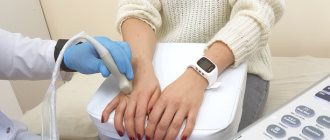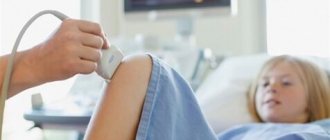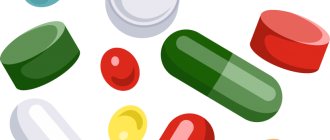A pinched nerve is a pathological condition that progresses with mechanical compression of the nerve fiber by muscles, tumors, vertebrae, etc. Characterized by severe pain.
Pinched nerve is a pathology that progresses due to compression of the nerve fiber coming from the spinal cord by nearby localized vertebrae or tendons, muscle structures, benign or malignant neoplasms, protrusions and other mechanical “obstacles.”
Symptoms of a pinched nerve are pronounced. The patient experiences severe pain in the affected area, often experiencing numbness in this area, impaired muscle function, and much more. There are many forms of this pathology, but in medical practice the following are more common:
- pinched sciatic nerve;
- pinched nerve in the lower back;
- pinched nerves of the cervical spine.
Local NSAIDs for back and lower back pain
Nonsteroidal anti-inflammatory drugs (NSAIDs) are drugs that effectively suppress inflammation and have an analgesic effect by reducing the activity of the cyclooxygenase enzyme. As a result, the synthesis of prostaglandins, compounds that play a key role in the development of inflammation and pain, is disrupted. Most often, NSAIDs are used in the form of tablets and injections, but in this form they often lead to side effects - stomach ulcers, gastric bleeding, blood clotting disorders, and kidney failure. Side effects occur especially often with long-term use.
Shpidonov Gennady Stanislavovich
Neurologist
Rostov State Medical University (neurology)
10 years of experience
Chronic back pain requires long-term use of painkillers and anti-inflammatory drugs. But what to do about side effects? To combat them, local remedies are used in the form of gels, patches and ointments, which also have an analgesic and anti-inflammatory effect for back pain, but without the disadvantages characteristic of NSAIDs. The use of this group of drugs in the form of local therapy is safer than injections and tablets. The presence in such products of substances that facilitate the penetration of NSAIDs into soft tissues increases the effectiveness of treatment.
Creams, ointments and gels with NSAIDs also help with acute back pain. Moreover, it is recommended to start treatment with local therapy, and only if there is no effect, switch to taking pills or giving injections. This way you will prevent the side effects of NSAIDs, the use of which for more than 3-5 days without consulting a doctor is fraught with complications.
The most common ointments, gels and patches with NSAIDs used for back and lower back pain:
- Nise;
- Fastum Gel;
- Voltaren Emulgel;
- Ketonal;
- Nurofen Express;
- Finalgel;
- Ibuprofen;
- Diclofenac;
- Dolgit.
Local therapy is almost always less effective compared to pills and injections. However, if the pain is not severe, it is better to try using ointments, gels and transdermal patches with NSAIDs.
Treatment
Help before diagnosis
For injuries to the collarbone, hang the arm in a bandage, apply cold, and give an analgesic. For non-traumatic pathologies without signs of severe inflammation, the arm is provided with rest, and painkillers and warming agents are applied to the painful area. Progression of pain, increased body temperature, the appearance of significant swelling and hyperemia is a reason to immediately contact a specialist.
Conservative therapy
In case of clavicle fractures, reposition is carried out; in children, the limb is fixed with Delbe rings, in adults - with a Deso bandage. Patients with bruises and non-traumatic diseases are advised to reduce the load on the limb. The protective regimen option is chosen taking into account the type of pathology; complete rest is recommended only during periods of exacerbations; the rest of the time it is advised to maintain sufficient physical activity to avoid atrophy and the development of contractures.
In the treatment of diseases of the collarbone, non-drug methods are widely used - massage, physical therapy. Shock wave therapy is considered a promising method. The following types of physiotherapy are used:
- medicinal electrophoresis;
- UHF;
- magnetic therapy;
- laser therapy;
- ultrasound;
- electrical stimulation.
The drug therapy plan is drawn up taking into account the characteristics of the disease. Infectious processes require antibiotic therapy. For chronic inflammatory and degenerative diseases, NSAIDs of general and local action are prescribed, and blockades with corticosteroid drugs are performed.
Surgery
Most often, operations on the collarbone are performed during the treatment of injuries and their consequences. Depending on the type of damage, the following is carried out:
- Osteosynthesis of the clavicle.
It is indicated as an emergency in case of damage or threat of damage to the neurovascular bundle by a bone fragment. It is performed as planned when reposition is ineffective and it is impossible to conservatively hold the fragments in the correct position. - Open reduction of dislocation.
Clavicle dislocations are easily reduced, but are poorly maintained and therefore require surgical treatment. Taking into account the location of the dislocation, plastic surgery of the acromioclavicular or sternoclavicular joint is performed. - Plastic surgery for pseudoarthrosis of the clavicle.
Recommended in the absence of fusion of fragments. The fragments are fixed using bone autograft.
If compression of blood vessels and nerves is caused by a congenital anomaly, resection of the cervical rib may be required. For other neurological causes of pain, neurosurgical interventions are performed in some cases. The tumors are excised or bone resection is performed.
Ointments with bee and snake venom
Bee and snake venom have been used for medicinal purposes since ancient times. A detailed description of such therapy is found in Hippocrates, Avicenna, Galen and many other healers. Modern research confirms the ability of bee and snake venom to have a number of positive effects in diseases of the musculoskeletal system and nervous system. The enzymes it contains (phospholipase, hyaluronidase, phosphatase), toxins, and biologically active substances have a locally irritating and distracting, reflex, analgesic and anti-inflammatory effect.
Under the influence of the poison, a reflex expansion of blood vessels occurs, microcirculation improves, the permeability of the vascular wall increases, regeneration is stimulated and tissue nutrition improves. Direct anti-inflammatory and analgesic effect relieves swelling and inflammation. The addition of excipients such as salicylic acid and mustard oil enhances the effect of ointments for back and lower back pain.
It is important to remember that the use of ointments with bee and snake venom is strictly contraindicated in case of allergies to bee products, polyvalent allergies, or a tendency to anaphylactic shock. In such patients, even small amounts of poison can cause severe allergic reactions, including swelling of the upper respiratory tract and anaphylaxis.
The most common ointments with bee or snake venom for back and lower back pain:
- Apizartron;
- Viprosal;
- Virapin.
Shpidonov Gennady Stanislavovich
Neurologist
Rostov State Medical University (neurology)
10 years of experience
Gels and ointments that increase blood circulation
Gels and ointments that increase blood circulation usually consist of capsaicin and its derivatives (the substance responsible for the spicy taste of pepper), other substances that have a vasodilating, warming and irritating effect. The drug helps to increase local blood flow, improves microcirculation, and due to intense burning on the skin, stimulates the natural mechanisms of pain control (distracting effect). Vasodilation and increased blood flow help improve metabolism in the underlying tissues, including those affected by degenerative and inflammatory processes.
Before starting use, it is recommended to carry out a test - allergic reactions are possible; in some patients with sensitive skin, the drug causes an intolerable burning sensation (in such cases, it is necessary to wash off the product with warm water and soap).
Common ointments that increase blood circulation for back and lower back pain:
- Nicoflex
- Finalgon
- Capsicam
Chondroprotective ointments for lower back pain
Chondroprotectors are drugs that have the ability to slow down the process of destruction (degeneration) of cartilage tissue and stimulate its regeneration. These are mainly glucosamine and chondroitin. There are various ointments with glucosamine and/or chondroitin, however, due to the fact that these substances do not pass through the skin well (they are high-molecular compounds), the effectiveness of these products is questioned. Chondroprotectors have the greatest effect when administered intramuscularly and orally, however, even in this case, several courses of treatment are required to achieve an effect.
Shpidonov Gennady Stanislavovich
Neurologist
Rostov State Medical University (neurology)
10 years of experience
Common chondroprotective ointments for back and lower back pain:
- Sofia Chondroitin glucosamine complex
- Chondroitin
Such products include various creams, ointments, gels and balms, recommended for back pain, and containing collagen, mumiyo, oils, including essential oils, extracts of medicinal herbs, alum, shungite, etc. The effectiveness of such drugs (Shungite, Dr. Theiss Comfrey with vitamin E, Valentin Dikul Balm) has not been tested by clinical studies, and remains on the conscience of the manufacturer.
Symptoms of a pinched nerve
The most common type of nerve entrapment is a sciatic nerve entrapment . There are few symptoms of this disease. Basically, this is a sharp pain that starts from the back, its lower part and spreads along the entire length of the nerve. Limitation of movements, burning sensation, and numbness of the limb are also common.
The feelings are not pleasant, therefore, if signs indicating a pinched sciatic nerve are found, you need to seek professional help from a doctor.
Homeopathic ointments for back and lower back pain
Homeopathy is a branch of alternative medicine that uses the principle of similarity for treatment (like cures like). Homeopaths use ultra-low concentrations of various substances of mineral or organic origin as medicine. Numerous studies of the effectiveness of homeopathic remedies have not found the therapeutic effect described by adherents of homeopathy - with the exception of the placebo effect.
There are various homeopathic remedies available for topical, oral or injection use that the manufacturer claims can treat back pain. Such drugs often contain poisonous and toxic compounds (such as mercury, heavy metals, poisonous plants). Homeopathy should only be used as an adjuvant therapy for diseases that do not pose a risk of serious complications or death. The use of homeopathic remedies in children is prohibited.
Common homeopathic remedies for back pain:
- Traumeel C
- Target T
Symptoms of a pinched nerve in the thoracic region
The main symptom of this pathology is pain of a different nature - sharp, aching or spasmodic. Unpleasant sensations can innervate internal organs and also constrain the chest.
On palpation, nodular formations are observed in the intercostal muscles. Unpleasant symptoms may intensify with sudden movements, sneezing or coughing, and may also be more pronounced when weather conditions change.
Very often, symptoms of a pinched thoracic nerve are confused with signs of heart disease, since the pain radiates to the left side of the chest and left arm.
A distinctive feature of pinched nerve pain is that the symptoms cannot be relieved with nitroglycerin and other heart medications.
Compression may be accompanied by increased sweating, redness and impaired sensitivity of the skin, as well as cramps of the back muscles.
Causes of back pain
The source of back pain can be various anatomical structures and soft tissues of the spine and spinal cord. The direct cause of the pain syndrome can be inflammation (for example, with spondyloarthritis, ankylosing spondylitis, osteochondrosis), external pressure on the nerve fibers and the spinal cord itself (with a herniated disc, radiculitis, sciatica, tumor of the spinal cord membranes), trauma (back contusion, fracture spine), muscle spasm. Most often, pain is a consequence of a complex of causes - in most cases there is inflammation, muscle spasm, and external pressure.
Etiological factors
Pinched nerves in the cervical spine, lower back and other places most often occur due to:
- osteochondrosis;
- body weight that does not meet the norm;
- infectious diseases;
- fast or awkward movement;
- traumatization: pinching can be caused by a dislocation, fracture, bruise, etc.;
- vertebral displacements: pinching of the cervical nerve is often observed precisely for this reason;
- heavy load on the spine;
- hormonal imbalance in the body.
Indications for the use of ointments for the back
Ointments, gels and transdermal patches are indicated for pain caused by spinal disease - these are effective means to combat pain and inflammation in osteochondrosis, intervertebral hernia, neuralgia, radiculitis, spondyloarthrosis and spondyloarthritis. However, like any other therapy, local treatment has its limitations. Due to the fact that the skin acts as a powerful barrier and prevents the penetration of large quantities of the active substance of the ointment or gel, it is difficult to achieve a pronounced effect. Therefore, patients, not receiving the expected effect, begin to think about what else to apply to themselves for back pain. The effectiveness of ointments and gels depends on the cause of the pain - a mandatory consultation with a medical specialist will help you understand in which case local therapy is effective and in which it is not.
General contraindications
Ointments, gels and patches have general contraindications:
- Violation of the integrity of the skin in the area of application;
- Inflammatory processes on the skin in the area of application;
- Allergic reactions to components of ointments, gels and patches (including excipients, such as the adhesive base of the patch);
- Skin diseases in the area of application (ulcers, rashes);
- Childhood and pregnancy may also be a contraindication for the use of ointments, gels and patches.
The use of local therapy is ineffective for serious pathologies of the spine and spinal cord (tumors, severe injuries, multiple sclerosis, spinal tuberculosis, etc.).
Shpidonov Gennady Stanislavovich
Neurologist
Rostov State Medical University (neurology)
10 years of experience
Diagnostics
The diagnosis is established by an orthopedic traumatologist. For neurological causes of pain, diagnosis is carried out by a neurologist; for somatic pathology, the examination is carried out by doctors of relevant specialties. The following diagnostic procedures are prescribed:
- X-ray of the clavicle.
Basic research for pathology of bones and joints. The images visualize fracture lines, displacement of articular surfaces during dislocations, disturbances in the structure and shape of bones due to tumors, osteomyelitis, osteitis deformans, deformations, changes in the configuration of joints due to arthrosis and psoriatic arthritis. - Ultrasound of soft tissues.
It is performed to assess the condition of the soft tissue structures surrounding the collarbone. Reveals signs of inflammation and degeneration, foci of calcification. If blood vessels are compressed, special ultrasound examinations may be performed. - CT and MRI of the clavicle.
They are carried out to detail the nature, location and extent of pathological changes, clarify data obtained during other diagnostic procedures, and select conservative or surgical treatment tactics. - Neurological EFI.
If a neurological etiology of the pain syndrome is suspected, patients are shown electromyography or electroneurography. - Lab tests
. General and biochemical blood tests are prescribed to assess the general condition, identify signs of anemia, and the inflammatory process.
The list of studies for damage to internal organs is determined individually. For pathological processes in the chest area, an ECG, radiography of the chest cavity, and CT of the chest organs are prescribed. For diseases of the hepatobiliary zone, ultrasound, MRI and CT scans of the liver and gallbladder are performed, as well as tests to determine the level of bilirubin. For symptoms of other diseases of the abdominal cavity, an ultrasound of the abdominal organs is performed. If there are signs of intra-abdominal bleeding, diagnostic laparoscopy is performed.
Radiography. Clavicle fracture
